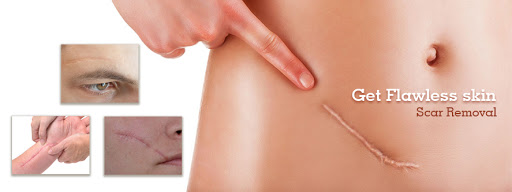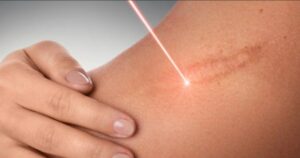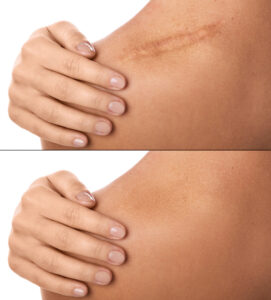
Laser Scar Removal: Which Types of Scars Can It Treat?
Raised scars from surgery, piercings, or other traumas
Your body has lots of built-in mechanisms for healing itself. Unfortunately, sometimes it gets a little carried away. When traumas like surgery, body piercings, vaccinations, or blisters injure the skin, the body can sometimes heal a little too aggressively, producing an excess amount of skin to close up the site of injury. When this happens, a keloid scar can form. Keloids are firm, raised scars that appear red or purplish in color. They can grow over time, and if keloid scars get big enough, they may even start to hamper your movement.
Another type of raised scar is hypertrophic. These scars form just like keloids, but they stay close to the site of the injury, whereas keloid scars extend to a larger area of skin. Hypertrophic scars usually look pink, and they can fade over time. Laser therapy can help flatten both keloid and hypertrophic scars and reduce the redness, making them less prominent

Acne scars
Acne scars can be raised or pitted. Either way, they’re no fun. Most people get pitted scars after a bad bout of acne, which means the acne leaves little indentations in the skin. There are varying types of acne scars, including ice pick scars, boxcar scars, and rolling scars. Depending on the severity of your acne and how well your skin heals naturally, your acne scars may be large or small. In some cases, they might be barely noticeable. Other times, large, deep acne scars can make you extremely self-conscious.
Laser treatment can help close up your pitted acne scars and reduce their size. Using light to poke tiny holes in the skin, the laser will stimulate your skin’s growth so that it fills in the depressions for a smoother, more even look. This approach can also work for other types of pitted scars, like those left over from chickenpox.
Burn scars
Burn scars can be tricky to get rid of, but there are lasers that can help. For example, the pulsed dye laser targets damaged blood vessels in your skin, reducing redness and inflammation by focusing on one small area at a time. Other lasers use light and heat therapy or poke holes to stimulate the growth of new, healthy collagen in place of the burned skin.



